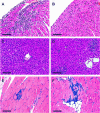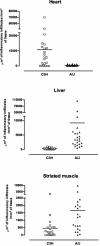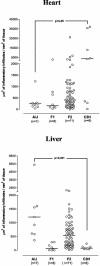Pathology affects different organs in two mouse strains chronically infected by a Trypanosoma cruzi clone: a model for genetic studies of Chagas' disease
- PMID: 15039360
- PMCID: PMC375186
- DOI: 10.1128/IAI.72.4.2350-2357.2004
Pathology affects different organs in two mouse strains chronically infected by a Trypanosoma cruzi clone: a model for genetic studies of Chagas' disease
Abstract
Chagas' disease is a chronic infection caused by Trypanosoma cruzi and represents an important public health burden in Latin America. Frequently the disease evolves undetectable for decades, while in a significant fraction of the affected individuals it culminates in death by heart failure. Here, we describe a novel murine model of the chronic infection with T. cruzi using a stable clone isolated from a human patient (Sylvio X10/4). The infection in the C3H/HePAS mouse strain progresses chronically and is mainly characterized by intense cardiac inflammatory lesions that recapitulate the chronic cardiac pathology observed in the human disease. Moderate striated muscle lesions are also present in C3H/HePAS mice. Viable parasites are detected and recovered from the chronic heart lesions of C3H/HePAS mice, supporting the current notion that development of heart pathology in Chagas' disease is related to parasite persistence in the inflamed tissue. By contrast, in infected A/J mice, chronic inflammatory lesions are targeted to the liver and the skeletal muscle, while pathology and parasites are undetectable in the heart. The phenotypic analysis of F(1) (A/J x C3H/HePAS) and F(2) (A/J x C3H/HePAS) mice suggests that the genetic predisposition to develop the inflammatory lesions caused by T. cruzi (Sylvio X10/4 clone) is heterogeneous because the heart and liver pathology segregate in the F(2) generation. These findings raise the hypothesis that the pathology heterogeneity observed in humans with Chagas' disease (absence and presence of cardiac or digestive chronic lesions) may be attributable to host genetic factors.
Figures








Similar articles
-
Parasite persistence correlates with disease severity and localization in chronic Chagas' disease.J Infect Dis. 1999 Aug;180(2):480-6. doi: 10.1086/314889. J Infect Dis. 1999. PMID: 10395865
-
IFN-gamma, but not nitric oxide or specific IgG, is essential for the in vivo control of low-virulence Sylvio X10/4 Trypanosoma cruzi parasites.Scand J Immunol. 2007 Aug-Sep;66(2-3):297-308. doi: 10.1111/j.1365-3083.2007.01958.x. Scand J Immunol. 2007. PMID: 17635807
-
Studies of Trypanosoma cruzi clones in inbred mice. I. A comparison of the course of infection of C3H/HEN- mice with two clones isolated from a common source.Am J Trop Med Hyg. 1983 May;32(3):497-506. doi: 10.4269/ajtmh.1983.32.497. Am J Trop Med Hyg. 1983. PMID: 6407346
-
Infection by the Sylvio X10/4 clone of Trypanosoma cruzi: relevance of a low-virulence model of Chagas' disease.Microbes Infect. 2009 Nov;11(13):1037-45. doi: 10.1016/j.micinf.2009.07.011. Epub 2009 Aug 4. Microbes Infect. 2009. PMID: 19660570 Review.
-
Trypanosoma cruzi-induced molecular mimicry and Chagas' disease.Curr Top Microbiol Immunol. 2005;296:89-123. doi: 10.1007/3-540-30791-5_6. Curr Top Microbiol Immunol. 2005. PMID: 16323421 Review.
Cited by
-
Challenge of chronically infected mice with homologous trypanosoma cruzi parasites enhances the immune response but does not modify cardiopathy: implications for the design of a therapeutic vaccine.Clin Vaccine Immunol. 2013 Feb;20(2):248-54. doi: 10.1128/CVI.00032-12. Epub 2012 Dec 19. Clin Vaccine Immunol. 2013. PMID: 23254299 Free PMC article.
-
The use of a heterogeneously controlled mouse population reveals a significant correlation of acute phase parasitemia with mortality in Chagas disease.PLoS One. 2014 Mar 20;9(3):e91640. doi: 10.1371/journal.pone.0091640. eCollection 2014. PLoS One. 2014. PMID: 24651711 Free PMC article.
-
Trypanosoma cruzi: experimental parasitism in the central nervous system of albino mice.Parasitol Res. 2012 Nov;111(5):2099-107. doi: 10.1007/s00436-012-3057-9. Epub 2012 Aug 7. Parasitol Res. 2012. PMID: 22868891
-
Oral infection of mice and host cell invasion by Trypanosoma cruzi strains from Mexico.Parasitol Res. 2019 May;118(5):1493-1500. doi: 10.1007/s00436-019-06254-5. Epub 2019 Mar 8. Parasitol Res. 2019. PMID: 30847614
-
A parent-of-origin effect determines the susceptibility of a non-informative F1 population to Trypanosoma cruzi infection in vivo.PLoS One. 2013;8(2):e56347. doi: 10.1371/journal.pone.0056347. Epub 2013 Feb 11. PLoS One. 2013. PMID: 23409175 Free PMC article.
References
-
- Andrade, L. O., C. R. Machado, E. Chiari, S. D. Pena, and A. M. Macedo. 1999. Differential tissue distribution of diverse clones of Trypanosoma cruzi in infected mice. Mol. Biochem. Parasitol. 100:163-172. - PubMed
-
- Andrade, S. G., and Z. A. Andrade. 1968. Pathology of prolonged experimental Chagas’ disease. Rev. Inst. Med. Trop. Sao Paulo 10:180-187. - PubMed
-
- Anez, N., H. Carrasco, H. Parada, G. Crisante, A. Rojas, C. Fuenmayor, N. Gonzalez, G. Percoco, R. Borges, P. Guevara, and J. L. Ramirez. 1999. Myocardial parasite persistence in chronic chagasic patients. Am. J. Trop. Med. Hyg. 60:726-732. - PubMed
-
- Cunha-Neto, E., V. Coelho, L. Guilherme, A. Fiorelli, N. Stolf, and J. Kalil. 1996. Autoimmunity in Chagas’ disease. Identification of cardiac myosin-B13 Trypanosoma cruzi protein crossreactive T cell clones in heart lesions of a chronic Chagas’ cardiomyopathy patient. J. Clin. Investig. 98:1709-1712. - PMC - PubMed
Publication types
MeSH terms
LinkOut - more resources
Full Text Sources
Medical
Miscellaneous

